Three posters highlighting the key components of a desktop, laptop or table workstation.
Use this teaching resource when studying digital technologies in your classroom.
Download includes colour and black and white versions.
Updated: 20 Jul 2019
Three posters highlighting the key components of a desktop, laptop or table workstation.
Non-Editable: PDF
Pages: 3 Pages
Years: F - 4
Explore the characteristics and properties of materials and components that are used to produce designed solutions
Use materials, components, tools, equipment and techniques to safely make designed solutions
Investigate the suitability of materials, systems, components, tools and equipment for a range of purposes
Recognise and explore digital systems (hardware and software components) for a purpose
Explore how people safely use common information systems to meet information, communication and recreation needs
Identify and explore a range of digital systems with peripheral devices for different purposes, and transmit different types of data
Identifies that objects are made of materials that have observable properties
Identifies digital systems and explores how instructions are used to control digital devices
Describes how the properties of materials determine their use
Questions, plans and conducts scientific investigations, collects and summarises data and communicates using scientific representations
Describes how agricultural processes are used to grow plants and raise animals for food, clothing and shelter
Identifies that objects are made of materials that have observable properties
Identifies digital systems and explores how instructions are used to control digital devices
Describes how the properties of materials determine their use
Questions, plans and conducts scientific investigations, collects and summarises data and communicates using scientific representations
Describes how agricultural processes are used to grow plants and raise animals for food, clothing and shelter
Explore the characteristics and properties of materials and components that are used to create designed solutions
Use materials, components, tools, equipment and techniques to produce designed solutions safely
Identify and explore digital systems (hardware and software components) for a purpose
Explore how people safely use common information systems to meet information, communication and recreation needs
Explore the characteristics and properties of materials and components that are used to create designed solutions
Use materials, components, tools, equipment and techniques to produce designed solutions safely
Identify and explore digital systems (hardware and software components) for a purpose
Explore how people safely use common information systems to meet information, communication and recreation needs
Explore the characteristics and properties of materials and components that are used to create designed solutions
Use materials, components, tools, equipment and techniques to produce designed solutions safely
Identify and explore digital systems (hardware and software components) for a purpose
Explore how people safely use common information systems to meet information, communication and recreation needs
Investigate the suitability of materials, systems, components, tools and equipment for a range of purposes
Explore a range of digital systems with peripheral devices for different purposes, and transmit different types of data
Investigate the suitability of materials, systems, components, tools and equipment for a range of purposes
Explore a range of digital systems with peripheral devices for different purposes, and transmit different types of data
Recognise and explore digital systems (hardware and software) for a purpose
Generate, communicate and evaluate design ideas, and use materials, equipment and steps to safely make a solution for a purpose
Identify and explore digital systems and their components for a purpose
Discuss how existing digital systems satisfy identified needs for known users
Explore how technologies including materials affect movement in products
Use materials, components, tools, equipment and techniques to safely make designed solutions
Explore and describe a range of digital systems and their peripherals for a variety of purposes
Explore transmitting different types of data between digital systems
Describe how forces and the properties of materials affect function in a product or system
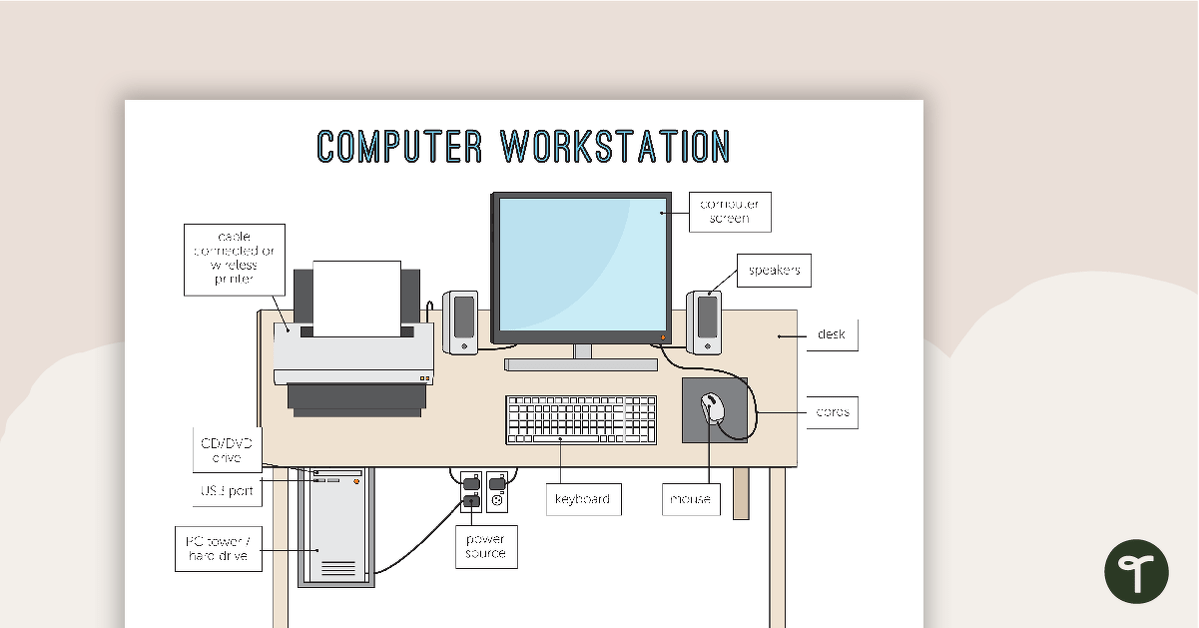
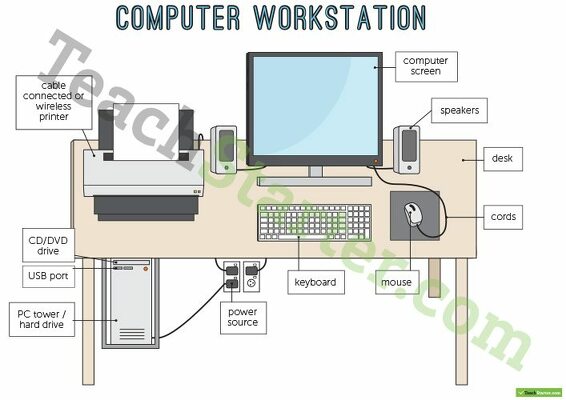
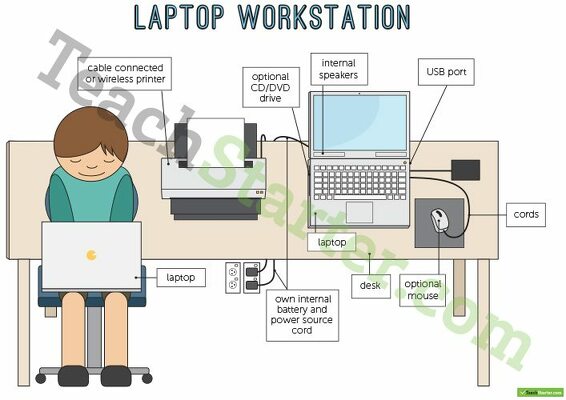
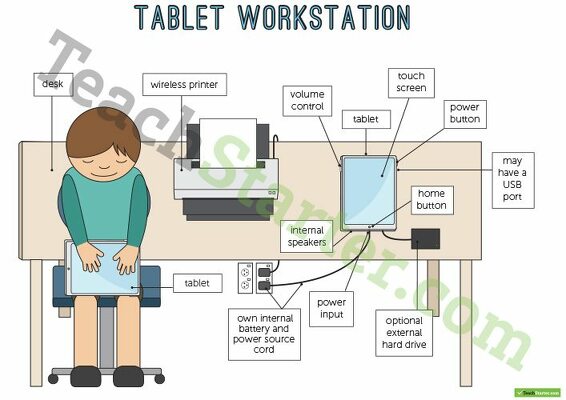
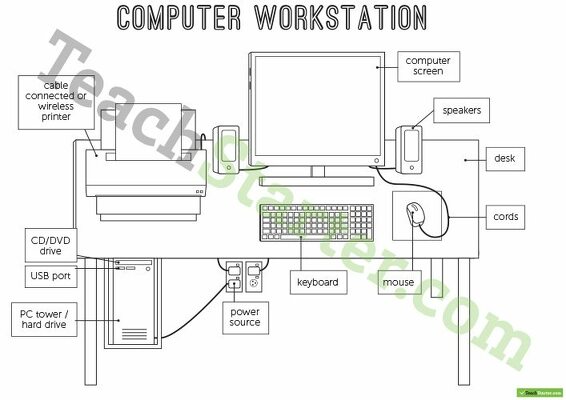
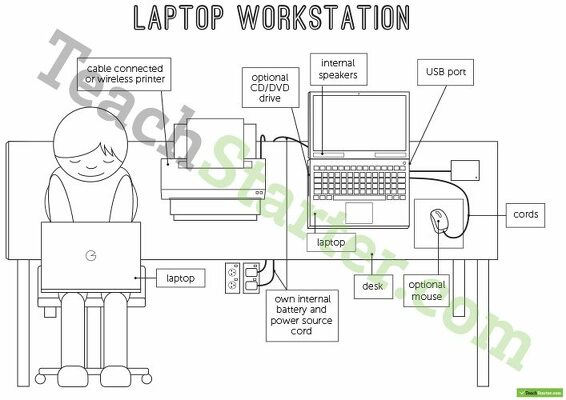
Three posters highlighting the key components of a desktop, laptop or table workstation.
Use this teaching resource when studying digital technologies in your classroom.
Download includes colour and black and white versions.
Explore the characteristics and properties of materials and components that are used to produce designed solutions
Use materials, components, tools, equipment and techniques to safely make designed solutions
Investigate the suitability of materials, systems, components, tools and equipment for a range of purposes
Recognise and explore digital systems (hardware and software components) for a purpose
Explore how people safely use common information systems to meet information, communication and recreation needs
Identify and explore a range of digital systems with peripheral devices for different purposes, and transmit different types of data
Identifies that objects are made of materials that have observable properties
Identifies digital systems and explores how instructions are used to control digital devices
Describes how the properties of materials determine their use
Questions, plans and conducts scientific investigations, collects and summarises data and communicates using scientific representations
Describes how agricultural processes are used to grow plants and raise animals for food, clothing and shelter
Identifies that objects are made of materials that have observable properties
Identifies digital systems and explores how instructions are used to control digital devices
Describes how the properties of materials determine their use
Questions, plans and conducts scientific investigations, collects and summarises data and communicates using scientific representations
Describes how agricultural processes are used to grow plants and raise animals for food, clothing and shelter
Explore the characteristics and properties of materials and components that are used to create designed solutions
Use materials, components, tools, equipment and techniques to produce designed solutions safely
Identify and explore digital systems (hardware and software components) for a purpose
Explore how people safely use common information systems to meet information, communication and recreation needs
Explore the characteristics and properties of materials and components that are used to create designed solutions
Use materials, components, tools, equipment and techniques to produce designed solutions safely
Identify and explore digital systems (hardware and software components) for a purpose
Explore how people safely use common information systems to meet information, communication and recreation needs
Explore the characteristics and properties of materials and components that are used to create designed solutions
Use materials, components, tools, equipment and techniques to produce designed solutions safely
Identify and explore digital systems (hardware and software components) for a purpose
Explore how people safely use common information systems to meet information, communication and recreation needs
Investigate the suitability of materials, systems, components, tools and equipment for a range of purposes
Explore a range of digital systems with peripheral devices for different purposes, and transmit different types of data
Investigate the suitability of materials, systems, components, tools and equipment for a range of purposes
Explore a range of digital systems with peripheral devices for different purposes, and transmit different types of data
Recognise and explore digital systems (hardware and software) for a purpose
Generate, communicate and evaluate design ideas, and use materials, equipment and steps to safely make a solution for a purpose
Identify and explore digital systems and their components for a purpose
Discuss how existing digital systems satisfy identified needs for known users
Explore how technologies including materials affect movement in products
Use materials, components, tools, equipment and techniques to safely make designed solutions
Explore and describe a range of digital systems and their peripherals for a variety of purposes
Explore transmitting different types of data between digital systems
Describe how forces and the properties of materials affect function in a product or system

We create premium quality, downloadable teaching resources for primary/elementary school teachers that make classrooms buzz!
Would you like something changed or customised on this resource? While our team makes every effort to complete change suggestions, we can't guarantee that every change will be completed.
Did you spot an error on this resource? Please let us know and we will fix it shortly.
Are you having trouble downloading or viewing this resource? Please try the following steps:
If you are still having difficulty, please visit the Teach Starter Help Desk or contact us .

A set of 4 significant Australian flags with explanations.

Eight flags from Africa.

A set of 12 Queensland Cursive entry and exit shuttles to join together to make a handwriting spaceship.

A set of 12 Queensland Cursive entry and exit shuttles to join together to make a handwriting spaceship.

A set of 12 Queensland Cursive entry and exit shuttles to join together to make a handwriting spaceship.

16 kid friendly yoga cards featuring poses to display and use in the classroom for daily gross motor and fitness activities.

A colourful banner highlighting some of Australia’s most recent historic events.

An inspirational poster for teachers to display on classroom bulletin boards.

A positivity poster encouraging kids to read.

A positive message to encourage students to dream big.
0 Comments
Write a review to help other teachers and parents like yourself. If you'd like to request a change to this resource, or report an error, select the corresponding tab above.